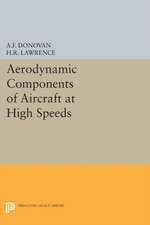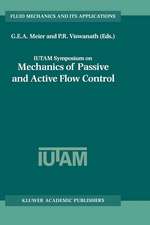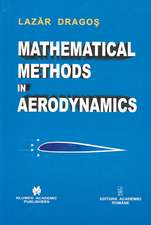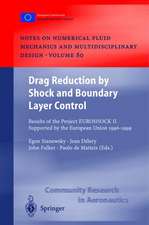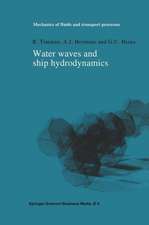Transition, Turbulence and Combustion Modelling: Lecture Notes from the 2nd ERCOFTAC Summerschool held in Stockholm, 10–16 June, 1998: ERCOFTAC Series, cartea 6
Editat de A. Hanifi, P.H. Alfredsson, A.V. Johansson, D. S. Hennigsonen Limba Engleză Hardback – 31 oct 1999
| Toate formatele și edițiile | Preț | Express |
|---|---|---|
| Paperback (1) | 1228.62 lei 6-8 săpt. | |
| SPRINGER NETHERLANDS – 15 oct 2012 | 1228.62 lei 6-8 săpt. | |
| Hardback (1) | 1234.94 lei 6-8 săpt. | |
| SPRINGER NETHERLANDS – 31 oct 1999 | 1234.94 lei 6-8 săpt. |
Din seria ERCOFTAC Series
- 18%
 Preț: 1568.47 lei
Preț: 1568.47 lei - 18%
 Preț: 948.29 lei
Preț: 948.29 lei - 18%
 Preț: 1854.80 lei
Preț: 1854.80 lei - 18%
 Preț: 959.36 lei
Preț: 959.36 lei - 18%
 Preț: 955.70 lei
Preț: 955.70 lei - 18%
 Preț: 1831.27 lei
Preț: 1831.27 lei - 18%
 Preț: 953.52 lei
Preț: 953.52 lei - 20%
 Preț: 1280.03 lei
Preț: 1280.03 lei - 18%
 Preț: 1224.06 lei
Preț: 1224.06 lei - 18%
 Preț: 1216.48 lei
Preț: 1216.48 lei - 15%
 Preț: 634.18 lei
Preț: 634.18 lei - 18%
 Preț: 944.51 lei
Preț: 944.51 lei - 18%
 Preț: 1227.36 lei
Preț: 1227.36 lei - 18%
 Preț: 1237.91 lei
Preț: 1237.91 lei - 20%
 Preț: 573.08 lei
Preț: 573.08 lei - 24%
 Preț: 1068.43 lei
Preț: 1068.43 lei - 24%
 Preț: 784.73 lei
Preț: 784.73 lei - 18%
 Preț: 955.25 lei
Preț: 955.25 lei - 18%
 Preț: 939.62 lei
Preț: 939.62 lei - 24%
 Preț: 892.07 lei
Preț: 892.07 lei -
 Preț: 387.96 lei
Preț: 387.96 lei - 18%
 Preț: 1391.21 lei
Preț: 1391.21 lei - 18%
 Preț: 1224.68 lei
Preț: 1224.68 lei -
 Preț: 396.62 lei
Preț: 396.62 lei - 18%
 Preț: 1230.66 lei
Preț: 1230.66 lei - 18%
 Preț: 1228.62 lei
Preț: 1228.62 lei - 18%
 Preț: 1248.68 lei
Preț: 1248.68 lei
Preț: 1234.94 lei
Preț vechi: 1506.03 lei
-18% Nou
Puncte Express: 1852
Preț estimativ în valută:
236.33€ • 256.62$ • 198.52£
236.33€ • 256.62$ • 198.52£
Carte tipărită la comandă
Livrare economică 22 aprilie-06 mai
Preluare comenzi: 021 569.72.76
Specificații
ISBN-13: 9780792359890
ISBN-10: 0792359895
Pagini: 532
Ilustrații: XII, 532 p.
Dimensiuni: 155 x 235 x 30 mm
Greutate: 0.94 kg
Ediția:1999
Editura: SPRINGER NETHERLANDS
Colecția Springer
Seria ERCOFTAC Series
Locul publicării:Dordrecht, Netherlands
ISBN-10: 0792359895
Pagini: 532
Ilustrații: XII, 532 p.
Dimensiuni: 155 x 235 x 30 mm
Greutate: 0.94 kg
Ediția:1999
Editura: SPRINGER NETHERLANDS
Colecția Springer
Seria ERCOFTAC Series
Locul publicării:Dordrecht, Netherlands
Public țintă
ResearchCuprins
1 Introduction.- 1.1 Equations for compressible flows.- 1.2 Laminar boundary layers.- 1.3 Combustion.- References.- 2 Stability of Boundary Layer Flows.- 2.1 Introduction.- 2.2 Introduction to stability of incompressible parallel flows.- 2.3 Stability of compressible parallel flows.- 2.4 Stability of non-parallel compressible flows.- 2.5 Applications.- References.- 3 Transition Prediction in Industrial Applications.- 3.1 Introduction.- 3.2 Qualitative description of some transition mechanisms.- 3.3 Some theoretical elements for “natural” transition.- 3.4 The eN method.- 3.5 Application to transonic flows : laminar flow control.- 3.6 Application to high speed flows.- 3.7 Conclusion.- References.- 4 An Introduction to Turbulence Modelling.- 4.1 Introduction.- 4.2 Basic properties of turbulence and the mean flow equation.- 4.3 Transport equations for single-point moments.- 4.4 The hierarchy and history of single-point closures.- 4.5 What should a closure fulfill?.- 4.6 Purely algebraic models.- 4.7 Eddy-viscosity based two-equation models.- 4.8 Differential Reynolds stress models for incompressible flow.- 4.9 Algebraic Reynolds stress models.- References.- 5 Modelling of Turbulence in Compressible Flows.- 5.1 Introduction.- 5.2 Averaged equations.- 5.3 Compressibility effects due to turbulent fluctuations and modelling of explicit compressibility terms.- 5.4 Transport equation models.- References.- 6 Large-Eddy Simulations of Incompressible and Compressible Turbulence.- 6.1 Introduction.- 6.2 Large-eddy simulation (LES) formalism.- 6.3 Smagorinsky’s model.- 6.4 Spectral Eddy-viscosity and eddy-diffusivity models.- 6.5 Return to physical space.- 6.6 Vortex control in a round jet.- 6.7 Rotating flows.- 6.8 Compressible LES formalism.- 6.9 Compressible mixing layer.-6.10 Compressible boundary layers on a flat plate.- 6.11 Conclusion.- References.- 7 Direct Numerical Simulations of Compressible Turbulent Flows: Fundamentals and Applications.- 7.1 Introduction.- 7.2 Physical nature of compressible turbulent flows.- 7.3 Governing equations.- 7.4 Numerical methods.- 7.5 DNS of compressible free-shear flows.- 7.6 DNS of shock-turbulence interaction.- 7.7 DNS of aerodynamically-generated sound.- 7.8 Concluding remarks.- References.- 8 Turbulent Combustion Modelling.- 8.1 Introduction.- 8.2 Mixture fraction based theories.- 8.3 Large-eddy simulations.- References.




